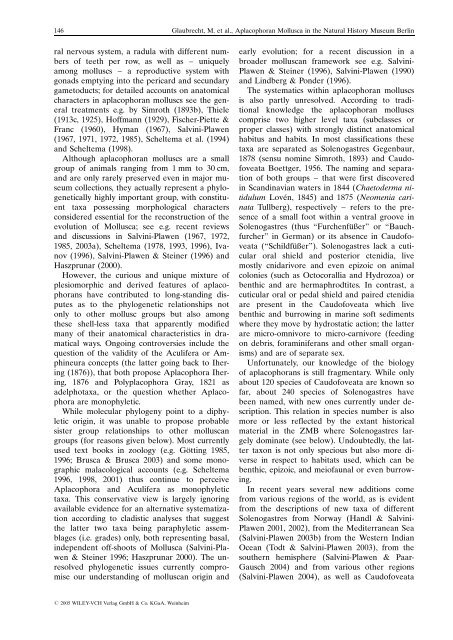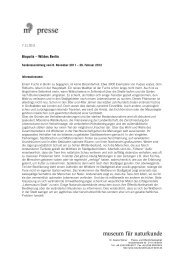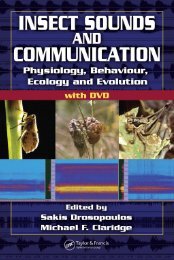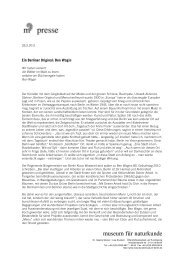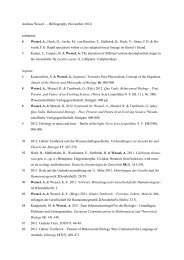Glaubrecht et al 2005.pdf - Download.naturkundemuseum-berlin.de ...
Glaubrecht et al 2005.pdf - Download.naturkundemuseum-berlin.de ...
Glaubrecht et al 2005.pdf - Download.naturkundemuseum-berlin.de ...
Create successful ePaper yourself
Turn your PDF publications into a flip-book with our unique Google optimized e-Paper software.
146<br />
r<strong>al</strong> nervous system, a radula with different numbers<br />
of te<strong>et</strong>h per row, as well as – uniquely<br />
among molluscs – a reproductive system with<br />
gonads emptying into the pericard and secundary<br />
gam<strong>et</strong>oducts; for d<strong>et</strong>ailed accounts on anatomic<strong>al</strong><br />
characters in aplacophoran molluscs see the gener<strong>al</strong><br />
treatments e.g. by Simroth (1893b), Thiele<br />
(1913c, 1925), Hoffmann (1929), Fischer-Pi<strong>et</strong>te &<br />
Franc (1960), Hyman (1967), S<strong>al</strong>vini-Plawen<br />
(1967, 1971, 1972, 1985), Scheltema <strong>et</strong> <strong>al</strong>. (1994)<br />
and Scheltema (1998).<br />
Although aplacophoran molluscs are a sm<strong>al</strong>l<br />
group of anim<strong>al</strong>s ranging from 1 mm to 30 cm,<br />
and are only rarely preserved even in major museum<br />
collections, they actu<strong>al</strong>ly represent a phylogen<strong>et</strong>ic<strong>al</strong>ly<br />
highly important group, with constituent<br />
taxa possessing morphologic<strong>al</strong> characters<br />
consi<strong>de</strong>red essenti<strong>al</strong> for the reconstruction of the<br />
evolution of Mollusca; see e.g. recent reviews<br />
and discussions in S<strong>al</strong>vini-Plawen (1967, 1972,<br />
1985, 2003a), Scheltema (1978, 1993, 1996), Ivanov<br />
(1996), S<strong>al</strong>vini-Plawen & Steiner (1996) and<br />
Haszprunar (2000).<br />
However, the curious and unique mixture of<br />
plesiomorphic and <strong>de</strong>rived features of aplacophorans<br />
have contributed to long-standing disputes<br />
as to the phylogen<strong>et</strong>ic relationships not<br />
only to other mollusc groups but <strong>al</strong>so among<br />
these shell-less taxa that apparently modified<br />
many of their anatomic<strong>al</strong> characteristics in dramatic<strong>al</strong><br />
ways. Ongoing controversies inclu<strong>de</strong> the<br />
question of the v<strong>al</strong>idity of the Aculifera or Amphineura<br />
concepts (the latter going back to Ihering<br />
(1876)), that both propose Aplacophora Ihering,<br />
1876 and Polyplacophora Gray, 1821 as<br />
a<strong>de</strong>lphotaxa, or the question wh<strong>et</strong>her Aplacophora<br />
are monophyl<strong>et</strong>ic.<br />
While molecular phylogeny point to a diphyl<strong>et</strong>ic<br />
origin, it was unable to propose probable<br />
sister group relationships to other molluscan<br />
groups (for reasons given below). Most currently<br />
used text books in zoology (e.g. Götting 1985,<br />
1996; Brusca & Brusca 2003) and some monographic<br />
m<strong>al</strong>acologic<strong>al</strong> accounts (e.g. Scheltema<br />
1996, 1998, 2001) thus continue to perceive<br />
Aplacophora and Aculifera as monophyl<strong>et</strong>ic<br />
taxa. This conservative view is largely ignoring<br />
available evi<strong>de</strong>nce for an <strong>al</strong>ternative systematization<br />
according to cladistic an<strong>al</strong>yses that suggest<br />
the latter two taxa being paraphyl<strong>et</strong>ic assemblages<br />
(i.e. gra<strong>de</strong>s) only, both representing bas<strong>al</strong>,<br />
in<strong>de</strong>pen<strong>de</strong>nt off-shoots of Mollusca (S<strong>al</strong>vini-Plawen<br />
& Steiner 1996; Haszprunar 2000). The unresolved<br />
phylogen<strong>et</strong>ic issues currently compromise<br />
our un<strong>de</strong>rstanding of molluscan origin and<br />
# 2005 WILEY-VCH Verlag GmbH & Co. KGaA, Weinheim<br />
<strong>Glaubrecht</strong>, M. <strong>et</strong> <strong>al</strong>., Aplacophoran Mollusca in the Natur<strong>al</strong> History Museum Berlin<br />
early evolution; for a recent discussion in a<br />
broa<strong>de</strong>r molluscan framework see e.g. S<strong>al</strong>vini-<br />
Plawen & Steiner (1996), S<strong>al</strong>vini-Plawen (1990)<br />
and Lindberg & Pon<strong>de</strong>r (1996).<br />
The systematics within aplacophoran molluscs<br />
is <strong>al</strong>so partly unresolved. According to tradition<strong>al</strong><br />
knowledge the aplacophoran molluscs<br />
comprise two higher level taxa (subclasses or<br />
proper classes) with strongly distinct anatomic<strong>al</strong><br />
habitus and habits. In most classifications these<br />
taxa are separated as Solenogastres Gegenbaur,<br />
1878 (sensu nomine Simroth, 1893) and Caudofoveata<br />
Bo<strong>et</strong>tger, 1956. The naming and separation<br />
of both groups – that were first discovered<br />
in Scandinavian waters in 1844 (Cha<strong>et</strong>o<strong>de</strong>rma nitidulum<br />
Lovén, 1845) and 1875 (Neomenia carinata<br />
Tullberg), respectively – refers to the presence<br />
of a sm<strong>al</strong>l foot within a ventr<strong>al</strong> groove in<br />
Solenogastres (thus “Furchenfüßer” or “Bauchfurcher”<br />
in German) or its absence in Caudofoveata<br />
(“Schildfüßer”). Solenogastres lack a cuticular<br />
or<strong>al</strong> shield and posterior ctenidia, live<br />
mostly cnidarivore and even epizoic on anim<strong>al</strong><br />
colonies (such as Octocor<strong>al</strong>lia and Hydrozoa) or<br />
benthic and are hermaphrodtites. In contrast, a<br />
cuticular or<strong>al</strong> or ped<strong>al</strong> shield and paired ctenidia<br />
are present in the Caudofoveata which live<br />
benthic and burrowing in marine soft sediments<br />
where they move by hydrostatic action; the latter<br />
are micro-omnivore to micro-carnivore (feeding<br />
on <strong>de</strong>bris, foraminiferans and other sm<strong>al</strong>l organisms)<br />
and are of separate sex.<br />
Unfortunately, our knowledge of the biology<br />
of aplacophorans is still fragmentary. While only<br />
about 120 species of Caudofoveata are known so<br />
far, about 240 species of Solenogastres have<br />
been named, with new ones currently un<strong>de</strong>r <strong>de</strong>scription.<br />
This relation in species number is <strong>al</strong>so<br />
more or less reflected by the extant historic<strong>al</strong><br />
materi<strong>al</strong> in the ZMB where Solenogastres largely<br />
dominate (see below). Undoubtedly, the latter<br />
taxon is not only specious but <strong>al</strong>so more diverse<br />
in respect to habitats used, which can be<br />
benthic, epizoic, and meiofaun<strong>al</strong> or even burrowing.<br />
In recent years sever<strong>al</strong> new additions come<br />
from various regions of the world, as is evi<strong>de</strong>nt<br />
from the <strong>de</strong>scriptions of new taxa of different<br />
Solenogastres from Norway (Handl & S<strong>al</strong>vini-<br />
Plawen 2001, 2002), from the Mediterranean Sea<br />
(S<strong>al</strong>vini-Plawen 2003b) from the Western Indian<br />
Ocean (Todt & S<strong>al</strong>vini-Plawen 2003), from the<br />
southern hemisphere (S<strong>al</strong>vini-Plawen & Paar-<br />
Gausch 2004) and from various other regions<br />
(S<strong>al</strong>vini-Plawen 2004), as well as Caudofoveata


